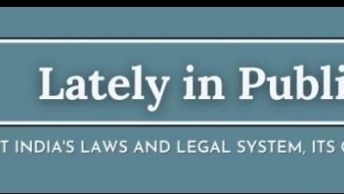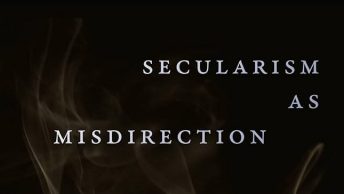Update: See link to yesterday’s death penalty judgment below.
Justice Sinha, arguably one of the most interesting judges on the Supreme Court today, retires on the 9th of August 2009. He has written many important judgments over the years. In this post, I want to highlight three issues on which his contribution will define Indian constitutionalism in the years to come – strict scrutiny, death penalty and the role of the judiciary as a counter-majoritarian institution.
Strict Scrutiny: Reinterpreting Thakur
Justice Sinha has perhaps been the most enthusiastic proponent of strict scrutiny and proportionality as the appropriate standard of review in constitutional cases. His famous judgment in Anuj Garg, and its subsequent application in Naz Foundation should be familiar to most readers. In what would probably be his last judgment on the issue, Justice Sinha has sought to clear the air on strict scrutiny. Although Subhash Chandra v. Delhi Subordinate Services Selection Board, delivered this week, does not directly mention Naz Foundation’s harmonious construction of Garg and Thakur, the motivation in Chandra appears to be to give Thakur an even more restricted interpretation than allowed by Naz. This judgment will fuel rather than settle the debate on strict scrutiny. Here are some excerpts [para 43]:
It is commonly believed amongst a section of Academicians that strict scrutiny test in view of the Constitution Bench decision of this Court in Ashok Kumar Thakur (supra) is not applicable in India at all.
…
The Constitution Bench in Ashok Kumar Thakur (supra), itself, held:
“252. It has been rightly contended by Mr Vahanvati and Mr Gopal Subramanium that there is a conceptual difference between the cases decided by the American Supreme Court and the cases at hand. In Saurabh Chaudri v. Union of India626 it was held that the logic of strict classification and strict scrutiny does not have much relevance in the cases of the nature at hand…” [Emphasis supplied]Saurabh Chaudri (supra) itself, therefore, points out some category of cases where strict scrutiny test would be applicable. Ashok Kumar Thakur (supra) solely relies upon Saurabh Chaudri to clarify the applicability of strict scrutiny and does not make an independent sweeping observation in that regard.
We are of the opinion that in respect of the following categories of cases, the said test may be applied:
1. Where a statute or an action is patently unreasonable or arbitrary. [See Mithu v. Stateof Punjab [(1983) 2 SCC 277].
2. Where a statute is contrary to the constitutional scheme. [See E.V. Chinniah (supra)].
3. Where the general presumption as regards the constitutionality of the statute or action cannot be invoked.
4. Where a statute or execution action causes reverse discrimination.
5. Where a statute has been enacted restricting the rights of a citizen under Article 14 or Article 19 as for example clauses (1) to (6) of Article 19 of the Constitution of India as in those cases, it would be for the State to justify the reasonableness thereof.
6. Where a statute seeks to take away a person’s life and liberty which is protected under Article 21 of the Constitution of India or otherwise infringes the core human right.
7. Where a statute is ‘Expropriatory’ or ‘Confiscatory’ in nature.
8. Where a statute prima facie seeks to interfere with sovereignty and integrity of India.However, by no means, the list is exhaustive or may be held to be applicable in all situations.
Perhaps the most interesting bit in this excerpt is the Court’s attempt to respond to academic criticism. Also, point 3 in the list supplied by Justice Sinha suggests there exists a category of laws which do not get the presumption of constitutionality. Wouldn’t colonial laws be in such a category?
Death Penalty: Towards abolition
The first steps towards doubting the constitutionality of death penalty were taken by Justice Sinha in Swamy Shraddananda. He further recognised the near-abolitionist spirit of the rarest-of-rare doctrine in Bachan Singh in landmark Santosh Bariyar case, discussed here and elsewhere.
Update: Justice Sinha’s concurring opinion in Mohd. Farooq Abdul Gafoor v. State of Maharashtra delivered yesterday is his final parting shot at death penalty. He cites the Law Commission’s 187th Report and Amnesty International’s Report titled “Lethal Lottery: The Death Penalty in India – A study of Supreme Court judgments in death penalty cases 1950-2006” and re-emphasises the arbitrariness point.
Judiciary as a counter-majoritarian institution
Garg and Bariyar share a common theme – that the role of unelected and insulated judges in a constitutional democracy is to uphold constitutional principles, especially in the face of majoritarian outcry. Influence Lifestyle Stores drew upon this judicial role (discussed here). The idea of the counter-majoritarian role of the judiciary is well-established in academic literature: Fuller and Ely providing two good explanations of the appropriate judicial role. Indeed, in Subhash Chandra, Justice Sinha cites Ely:
The political compulsions and extraneous vote considerations in the functioning of the legislature are mentioned by a prominent political science scholar, John Hart Ely in his landmark book, Democracy and Distrust. He says that “special scrutiny, in particular its demand for an essentially perfect fit, turns out to be a way of ‘flushing out’ unconstitutional motivation.”
Readers are invited to draw attention to his contribution to other areas of law in the comment section.






further interesting excerpts from Subhash Chandra:
At the heart of the applicability of this doctrine in protective discrimination cases, including affirmative action matters, is the challenge before the court to facilitate the translation of the constitutional vision of substantive equality into a practical feature of the polity. The enabling environment must have objectively laid down policy attributes so much so that the targeted benefits are accrued to parts of polity for which they are meant. As the final arbiter on constitutional interpretation, the court is duty bound to delineate the four corners of the legislative policy which is amenable to the constitutional epithets of equality as also to Article 21. The state has to play within the rules set by the court in this regard.
…
First responsibility of the court is to determine whether the ends purported to be sought by the executive are "compelling." This process is under the intense gaze of the court because the government is impinging upon somebody else’s core constitutional rights and therefore only the most pressing circumstances can justify the government action.
The other important responsibility is to inquire and assess that the law is a narrowly tailored means of furthering those governmental interests. Narrow tailoring should satisfy the court that the law capture within its reach just the adequate activity, neither more or less, than is necessary to advance those compelling ends. In the ultimate analysis, the State action must be narrowly drawn in a manner that it can qualify to be the least restrictive alternative available to pursue those ends. Without this inquiry into "fit" between the ends and the means enables it will not only be difficult for the courts to test the sincerity of the government's claimed objective but also the law may be suffer from the vice of arbitrariness. Article 14 guarantee against uncanalized and arbitrary laws has to be rigorously pursued by the court in this regard. The State in such cases may act not only through a law but also through an executive instrument like circular or even simple practice or convention and the intense gaze of the Court in this behalf is all pervasive. In fact, more inarticulate the State action would be, greater would be the intensity of the scrutiny by the courts.
…
Strict scrutiny thus paves the way for a more searching judicial scrutiny to guard against invidious discriminations which could have made by the State against group of people in violation of the constitutional guaranty of just and equal laws. The court must adopt a weighted balancing approach or in other words pursue an even-handed balancing of the interests.